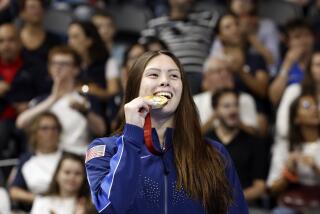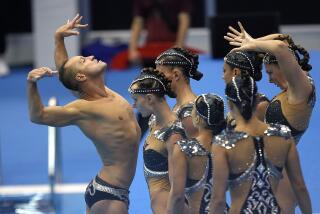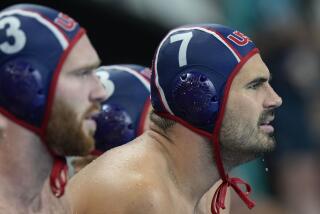SWIMMING / THERESA MUNOZ : All the Gold at the Meet Didn’t Come in Medals
Between Aug. 13 and last Sunday, seven world swimming records were broken, including all four backstroke marks.
Stanford’s Jeff Rouse shattered the 100-meter backstroke record in the Pan Pacific Championships at Edmonton, Canada; Spain’s Martin Zubero lowered the 200-meter backstroke record in the U.S. nationals at Ft. Lauderdale, Fla., and Hungarian Krisztina Egerszegi erased Betsy Mitchell’s women’s 100- and 200-meter backstroke records in the European Championships at Athens.
The debate continues on whether the new “no hand-touch” rule, which allows backstrokers to roll onto their stomach, somersault and push off the wall with their feet, is as beneficial as the unlimited underwater push-offs that were outlawed after American David Berkoff used them in setting the 100-meter record of 54.51 seconds in 1988.
Out of the starting blocks, Berkoff stayed underwater for 35 to 40 meters, and off the turn he was underwater for 15, leaving only 45 to 50 of actual backstroking. Initially, the “Berkoff rule” limited the underwater distance off the start and turns to 10 meters, then it was increased to 15, which Rouse used to maximum advantage in gaining his first world record.
“I don’t think (the new turn) is worth more than three-tenths of a second per turn,” Rouse said, “and for an elite backstroker it is probably not even that much. I think the change in the underwater rule had a lot more effect. For some people it is a push (the rules cancel each other out), but you can’t make a blanket statement.”
The U.S. Olympic Committee established a pot of $145,000 to be divided among the Pan Pacific medalists based on a point system that pays the most for a gold medal and the least for a bronze.
Thirty swimmers won individual medals or were part of medal-winning relay teams, but only 14 are eligible for funding because the others are subject to NCAA and high school rules that prohibit accepting money.
With the numbers reduced, it was a big payday--by swimming standards--for Matt Biondi, Janet Evans, Mike Barrowman, Angel Myers Martino and David Wharton.
Because U.S. Swimming is still determining whether the medalists in two non-Olympic events are eligible, the figures are not exact, but Biondi made about $37,000, Evans $34,000, Barrowman $26,000, Martino $22,000 and Wharton $19,000.
NCAA swimmers Rouse, Summer Sanders and Nicole Haislett missed out on perhaps $20,000 to $30,000 each (taking into account that the pot would have been divided more ways if they had been eligible).
Rouse also lost out on a $5,000 bonus from the USOC for breaking the world record and a $3,000 watch that the meet organizers offered for sharing swimmer-of-the-meet honors with Australian Kieren Perkins, the world record-setter in the 800-meter freestyle.
“It doesn’t really bother me a whole lot,” Rouse said, “because when you think about it, Mary T. (Meagher), Tracy (Caulkins), Rowdy (Gaines), Steve (Lundquist) and Pablo (Morales) swam all those years and they didn’t get a dime.”
Martino was thrilled because she and her husband, Mike, who is in graduate school, won’t have to eat macaroni and cheese every day.
“It is just going to help me train and live,” she said. “It’s not like I’m going to go out and buy a car.”
Martino, the first U.S. swimmer to serve a suspension for a positive anabolic steroids test, is being tested more often than the other members of the U.S. national team.
According to Dr. Alan Richardson, Martino is tested every three to six months, and while the other team members are tested randomly at major championships. Martino’s schedule was determined by the board of directors of U.S. Swimming, who banned her from competition for an 18-month period after her positive drug test at the 1988 U.S. Olympic trials.
Martino, who maintains her innocence, is supportive of the frequency of the tests because she believes they will remove any doubts.
Swimming Notes
Australian teen-ager Kieren Perkins, the new 800-meter freestyle world record-holder, got his start in swimming as part of rehabilitative therapy. At 8, Perkins ran through a sliding glass door while playing “tiggy”--similar to tag--with his brother. An artery was nearly severed, and 86 stitches were required to close the tear in his leg. Initially, he had to be carried into the pool. . . . Mike Barrowman, the other American to set a world record in the 13-day period this month, dedicated his 200-meter breaststroke mark of 2:10.60 in the U.S. nationals to his father, Ray Barrowman, who remains hospitalized in Potomac, Md. It was a difficult summer for Barrowman, because of concern for his father and his own battling U.S. Swimming Inc. for the right to compete in the U.S. nationals.
Eleven of the 16 winning women’s times in the Pan Pacific Championships were faster than those in the European Championships, but 10 of the 16 winning men’s times were faster in Europe. . . . The once-dominant German women’s team managed only two gold medals in the European meet. The women from Denmark, Norway and the Netherlands were improved, as was the Soviet men’s team, led by sprinter Alexander Popov.
After finishing 1-2 in the 50-meter freestyle at the Pan Pacific meet, former UCLA All-American Tom Jager and Matt Biondi of Castro Valley, Calif., gave their medals to two wheelchair-bound people. . . . Coming up: U.S. Swimming Convention, Sept. 15-22, Louisville, Ky.
More to Read
Go beyond the scoreboard
Get the latest on L.A.'s teams in the daily Sports Report newsletter.
You may occasionally receive promotional content from the Los Angeles Times.






